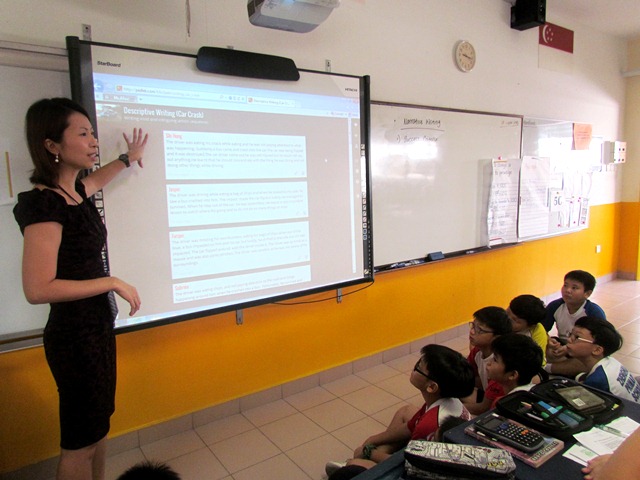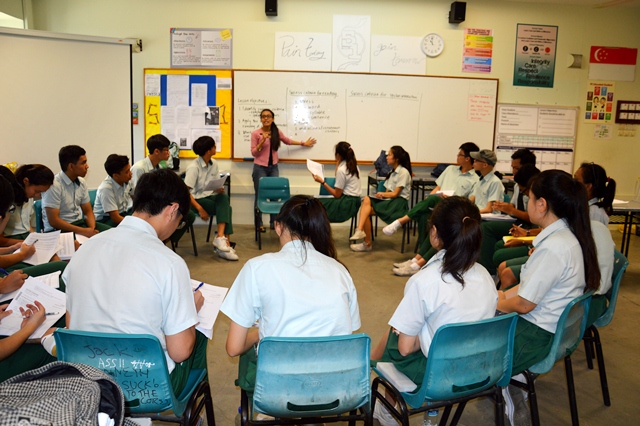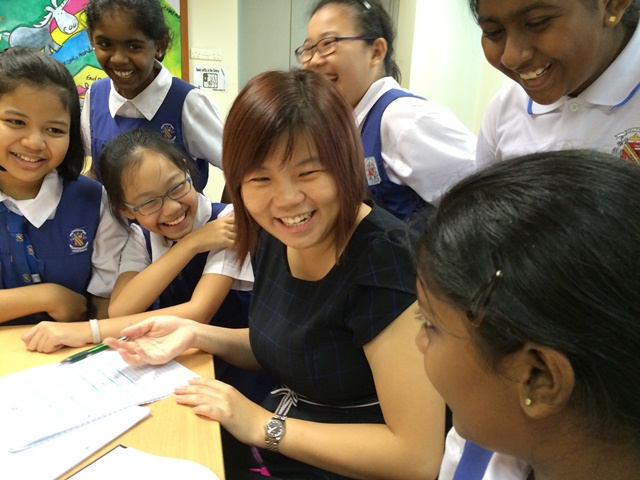English is no laughing matter. Or is it?
29 Sep 2015

Mdm Kerstin Wong loves teaching English but realises that not every student loves learning it. She gets creative – by setting up a Laughter Club to teach the language.
Wong Kai Xin Kerstin, Outstanding Youth in Education Award 2015 Finalist
Zhenghua Primary School
I start my lessons with laughter. Squid extensions, jellyfish dance… My demonstration of these laughter-inducing exercises, where I extend and stretch my arms in boneless wriggles, sends my class into peals of laughter and leads to a surge of “happy” hormones for a healthier start to the day.
Self-conscious about acting silly in front of my class? Not really. Building rapport with my students? Definitely!
My class and I chuckled and giggled our way through the English unit “What Happens When You Laugh”. I introduced laughing exercises from the first lesson and they became a mainstay.
There was a lot of positive energy and I decided to extend my students’ learning by challenging them to set up a Laughter Club. Our club had one mission – to make the world a happier place. We discussed what was required for a company to be set up, assuming that start-up funds and manpower were available. My students came up with the following: Board of Directors (to craft the company logo, vision, motto, service tagline, values and company history), Planning & Marketing Team (to create publicity and advertisement e.g. tele-sales, website, membership privileges), Sales Team (to create innovative laughter exercises including demonstrations and sales pitch) and Production Team (to create freebies e.g. joke books, health benefits research manual, and publicity materials like posters and brochures).
My aim was simple – to develop my students’ talents, build their proficiency in their language skills and promote collaboration and innovation. My students knew where their strengths lay and, with my guidance, selected the challenge task (ability-driven, self-awareness) that they were most interested in. The Board of Directors was an ambitious team who could conceptualise and write well. The Sales Team had the gift of the gab and high persuasive powers. The Planning & Marketing Team was an industrious and meticulous lot who listened to the needs of the target market and came up with business strategies. The Production Team was a creative crowd who used extensive research on laughter to their advantage. My students started to use phrases like “copyright infringements”, “intellectual property (IP)” and “benefits to people of different ages and fitness/ health levels”. I knew learning had taken place.
Is this relevant to learning English? Sure. Isn’t the ability to deliver a compelling and convincing sales pitch the mark of a confident speaker? Working within resource constraints makes them resilient and resourceful. Generating and evaluating information boosts critical thinking. Heated discussions on the pros and cons of ideas develop social and collaborative skills in an authentic setting.
Jane*, one of my students who used to be shy, blossomed into someone who could challenge her peers’ views when they were charting the direction of the company. She was steadfast in her beliefs that the company should be set up to benefit everyone’s quality of life and profit shouldn’t be the main focus. She didn’t have an easy time convincing the rest to agree with her. The glow on her face was priceless when the eventual vote from the team for her idea was unanimous.
It was an amazing transformation. My students were no longer passive receivers of knowledge. In those few weeks, my students learned so much more than grammar and vocabulary. They were independent learners who showed innovation and creativity and able to reflect on their learning. We laughed, we gelled and we learned.
Language acquisition is never easy. Even in a class, the entry level of each student varies. Is the teaching of English about imparting grammar rules and providing sufficient practice? Is learning English about repeating a fixed set of strategies until they are perfected? The answer is both “yes” and “no”. Laying the foundation helps students communicate effectively and experience some success in written assessments. But in order to inculcate the value of lifelong learning, I need to ensure that what grows within each student is a positive seed for learning beyond the activities that they perform in class.
Teachers subscribe to different teaching styles and are often most comfortable with the one that delivers results or what is deemed as the norm. So, does one style fit all – drill and practice, language discovery or something else? There’s no easy answer to that. My personal belief: what works best is when the teachers know their students and focus on their learning.
Winning formula? Make learning interesting and meaningful for the students. My role as the Head of Department of English Language gives me the opportunity to share strategies with the teachers. “How can I teach my students to write better?” is a common question asked by teachers. My response: create the scenario for them. If you want the students to detail a robbery scene, devote time to enact one for them. Convert the classroom for role play. Conduct a character study to deduce the reason for committing an offence or crime. Probe in-depth on the characters’ possible emotions and reactions. The vivid imagery and hands-on experience will stay with the students.
Teaching a story or theme that is dry or factual with technical terms but with no ideas how to get started? No worries; just ask yourself what aspect of the story or theme appeals to you and work from there. Start simple. That works for me.
Even the simplest of tasks can be interesting. To support my students in their writing, I would teach them how to identify good words and phrases. I called this “What Mrs Seah Likes”. I would come across a particular word or phrase and blurt out (rather comically) that that was “what Mrs Seah likes”. It caught on. Soon, my students would, on their own accord, read something and say to themselves that this would be something that “Mrs Seah likes”, and jot it down in their, you guessed it, “What Mrs Seah Likes” composition notebook.
I’ve always prioritised the engagement and enjoyment of my students before academic performance. Students need to develop a passion for learning and teachers need to create meaningful experiences for each unique child. I’m always learning from my students about how I can support their learning better.
Peter* was relatively weak in the English Language due to his infrequent exposure to and use of it. From my conversations with him, he viewed English Language as his stumbling block in learning. He rarely communicated using the English Language as he was conscious of the inaccuracy in his pronunciation and lack of expression. We agreed on reading a passage and learning the use of three vocabulary words in context each week as the set of success criteria and to put in effort together to monitor this to help him improve. The transformation in him after two years was astounding.
He could articulate his thoughts and hold discussions in English with his peers during my lessons. On Teachers’ Day in the second year, he wrote me a note in near-perfect English, telling me, “Thank you for being my teacher. If I go to secondary school, I would remember you and your wonderful lessons. I really appreciate it.”
Moments like this remind me that it’s not what the students made or produced that day that matters, but what they were made into and what was being produced in them that matters the most.
*Actual name has been changed.





